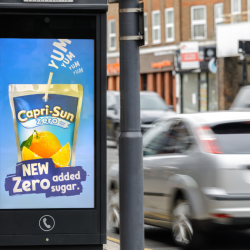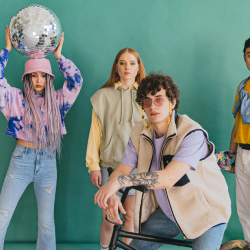TikTok transitions are not new…
Since the rise of the platform, we have seen countless content creators do outfit change transitions, throwing shoes into the air or falling onto laid-out clothes. We have seen travel transitions — with people filming themselves at the airport, jumping over their phones and into new destinations — as well as impressive makeup and Christmas decoration transitions.
While this type of content is not new, brands are now hopping on the trend and adding an unexpected twist. Smaller brands and larger corporations alike are using trending videos and adding their own humorous (although some might say ‘weird’) endings.
According to The Drum, this trend began in February of this year, when a São Paulo stationery shop uploaded a video of a person falling from a stretcher and blended it with a video of a store employee rolling on the floor and into shot, promoting their products.
This video garnered over 16 million views and 2.3 million likes. Seeing the attention it received, brands jumped on the bandwagon, with Currys, Iceland, and Central Houston Nissan all posting their own versions of the stretcher video. They received 2.5 million, 2.6 million, and 17.2 million views respectively.
The people want more
Since then, we have seen a surge in this type of content with most videos depicting someone falling over or getting injured. The reasoning behind why brands are choosing these types of videos is unclear but could have something to do with our tendency to laugh at ‘FAIL’ compilations on YouTube or America’s Funniest Home Videos.
It seems that Central Houston Nissan is now leading the race for attention and laughs, with its videos having more than a total of 7.8 million likes at the time of writing. The dealership recently uploaded a video of a man getting attacked by a dog and stitched it to a shot of an employee saying, ‘You ever feel attacked by salespeople? Not at Central Houston Nissan.’
This video received over 10 million views, with TikTok users commenting: ‘These get better and better each time’, ‘Best ad of 2024 so far’, ‘I’m sold’, and ‘TAKE MY MONEY’. Currys received similar praise after posting a tongue-in-cheek TikTok video of a horse kicking a chicken into a Ninja air fryer. Once again, the viewers left comments such as ‘I have never purposefully rewatched an advert,’ ‘This is the advertising I like to see,’ and ‘Why don’t they do these on tv?!’
Speaking to MediaCat Magazine about the decision to transition to this type of content, Ryan Todd, Senior Social Media and PR Manager at Currys, said: ‘The desire to post humorous content has always been part of our strategy, but we’ve worked very hard to tap into the latest trends recently. The importance of reacting to a trend as it’s on the rise has been where we’ve seen the best success — putting our spin on it before other brands.’
Going further, he explained that the team has seen ‘incredible results in the past six months’, with nine organic posts receiving more than 1 million views each in April alone.
Why are these ads so popular?
The short and simple answer is that they are entertaining. According to TikTok’s research, 7 in 10 viewers say ‘making people laugh’ is considered the most enjoyable aspect of watching TikTok ads. Remixing a trend was also found to lead to a 14% uplift in view time for ads. Moreover, 79% of users reportedly agree that brands should experiment with different topics and interests on TikTok. Considering all of the above, it is not surprising that brands who are experimenting by hopping on trends and remixing them with their own humorous endings will see a rise in engagement.
It is also important to note that creating this type of content is simple, easy, cheap (or even, free) and fun. In other words, smaller businesses can use these ads to grab the attention of new customers and raise their brand awareness without having a large budget.
Meanwhile, larger corporations can use humour to humanise themselves and attract a younger audience which values authenticity. In an interview with MediaCat Magazine, CEO and Co-Founder of the Gen Z market research platform Imagen Insights, Jay Richards commented: ‘It’s funny because they’re saying, “We don’t take ourselves too seriously. We’re only selling cars. We’re not conducting surgery. It’s not the end of the world.” I think not taking yourself seriously and just putting content there and seeing what works and just seeing what lands with people is great.‘
But does it convert?
While these videos are clearly receiving views and likes, it is not clear whether they lead to any sales. However, despite there being no way to measure this at present, there are a few reasons to believe that they do convert. Firstly, TikTok’s aforementioned research also uncovered that 30% of TikTok users say humour in creator content was a top motivation for purchase intent. In other words, being funny sells.
Earlier this month, I also attended EasyJet and DEPT’s session on ‘strategic silliness on social media’ at MAD//Fest. Following their presentation, I asked DEPT’s Business Director Phoebe Ord whether posting ‘silly videos’ on social media actually results in sales. While she confirmed that there is currently no way of measuring this, ‘the weird is what people remember’.
Richards echoed this view in our interview, explaining: ‘I would definitely say it converts because the truth of the matter is these people are going to be purchasing products anyway. So, take for example Duolingo, if I’m going to be using an app to learn another language, I’m going to choose the app that’s making me laugh and is constantly in my face.’
Ultimately, while silly clips are probably not here to stay, they serve as a reminder that being ‘weird’ and standing out from the sea of templated posts is an easy way to attract attention.
Featured image: Caique Araujo / Pexels


































